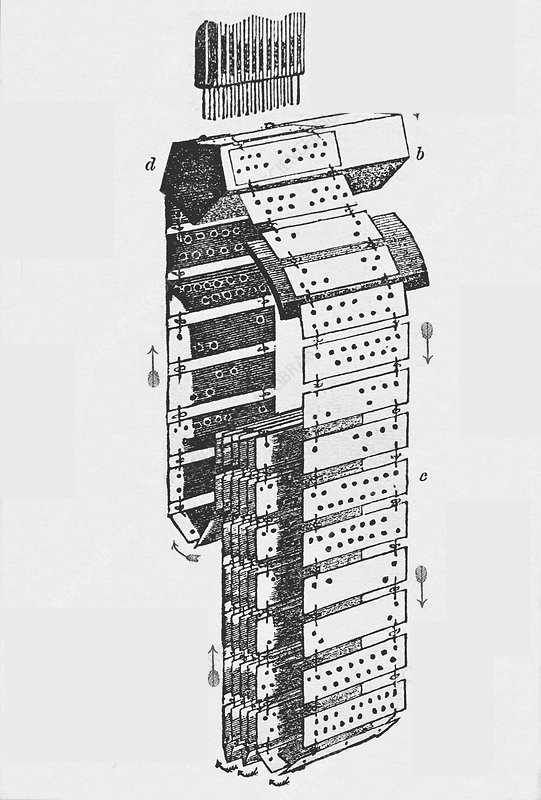“The Expanding Memory”: Thomas the Tank Engine and AI

Chapter 9 of Leroi-Gourhan’s Gesture and Speech, “The Expanding Memory” quickly tracks the technical medium of memory from oral transmission, to the increased organization of writing for non-linear access, to index and then punch cards, to a startlingly precient analysis of Artificial Intelligence (in ’64!) But, since one of our participants this week was zooming in from a train, we mostly talked about trains.
Of course, LG’s technical precursor of the externalization of gesture into code in this chapter is the Jaucqard loom not the train. But steam power has previously reared its dragon head as a technical force, and the train also plays a (somewhat hidden) pivotal role for LG in the reorganization of the social field via networked cities. Trains are not only, however, an early analogue precursor of the logic of switches, rule-bound action, and distributed externalized control of a closed system that will shape up digital computation. The kid's show Thomas the Tank Engine is perhaps emblematic of how this systemic logic organizes around a moral pedagogy of duty, in which a rigid moral order organizes around comformity to “use” within the system, and is regulated through isolation, shaming, and praise. Michel de Certeau is of course ahead of us, and in “Railway Navigation and Incarceration” from The Practice of Everyday Life (1974?), he argues that trains are machines of vision that infrastructurally frame the world as a spectacle. (Almost like a kind of inverse panopticon.)Trains are prisons disguised as mobility, enforcing a programmed or scripted logic of disciplinary society.
This is the paradox that LG will tight-rope walk in this chapter: as memory is offloaded from the gestures and oral transmission of everyday life (which reach their peak in guilds?) it will move into writing which increasingly organizes itself for diverse forms of pedagogic access (summaries, ToC’s, indexes, cards…). [And in a strange move, it will jump back into manual life through punch card systems, before jumping the tracks back into written digital code.] So the brain, mouth, and hand are increasingly freed from the burden of memory by external technologies. But at the same time, through these externalized forms memory and thought lose their fluidity and context-dependence for modes that are codified, repeatable, and scalable.
There is a similar, often underemphasized, tension, in LG’s argument: On the one hand, each new technological form fundamental reshapes the operations at play. Our memory is never the same, and each new form probes new forces and implications. On the other hand, LG rigorously continues to show the deep commitment each new form has to the conditions of its emergence in previous forms. This is true as vertebral life continues to build on top of previous configurations that inherit and transform hand, jaw, and posture. And it is true of writing/coding. LG’s pivotal argument in this chapter is that writing only explodes because it addressess a pent up potential/demand that was pushing urban forms: the separation of a managerial class from the worker/producer. This poses a paradox: we have to resist a simple evolutionary model of innovation for the more complex idea that every shift must emerge within a technical milieu that recognizes, supports and even creates the demand for new operational potentials. Punch cards are rehearsed and prepared by both writing and trains. And yet, at the same time, we have to see how these emergent conditions are (increasingly?) themselves technico-social, each layer navigating a set of freedoms and constraints that are in turn both freed from, and constrained by, previous layers.
These paradoxes are pushed to our current limit with Artificial Intelligence. What we are apparently seeing is the offloading not just of memory but of decision making or thinking, in the form of programmed behavior. The technics of memory becomes the new infrastructure for externalized “intelligence.” Whether this is some new kind of distributed intelligence or not, is an open question, but LG allows us to see one of the fundamental shifts: operations can now proceed without the hand. Or at least, the gestures of pre-written procedure as code, and the gestures by which these procedures are “run” through digital interfaces, are increasingly decoupled and sporadic. Perhaps one of the things that LG could not have seen was how Artificial Intelligence pushes us in two directions simultaneously: towards increasingly algorithmic and unsupervised decision making that operates as a kind of black-box, and also strangely back toward writing and “natural” language as an interface. Perhaps we would need Marshall McLuhan to help us make sense of this strange return of something like oracularity and orality.
In any case, in a nod to LG’s emphasis on the technology called the Table of Contents, this marks the end of section II “Memory and Rhythms.” The first section traced the literally mind-blowing notion of the expansion of the brain via the freeing of the hand and face toward speech, gesture and tool use, ending with the transitional moment of graphism. (Which both crosses over into our group on Diagrams, and also immediately shunts down the path of linear writing towards an emulation of non-linear thinking.) And so strangely—having freed the hand—Section II, which most directly deals with gesture, is in many ways already about the fundamental capture of gesture and rhythm into externalized programs. And now, we are on the cusp of Section III which will return us to the image…